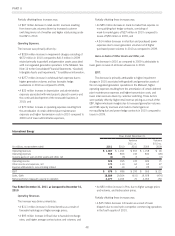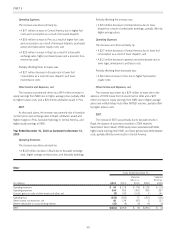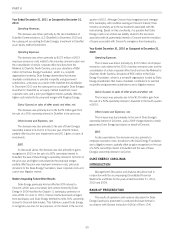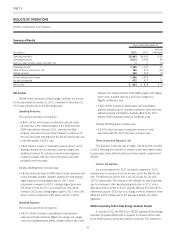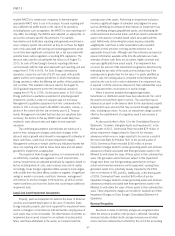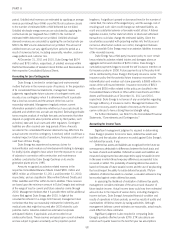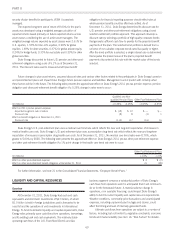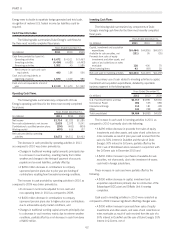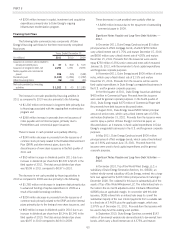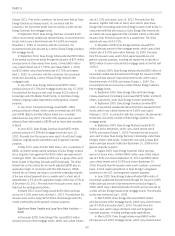Duke Energy 2011 Annual Report Download - page 78
Download and view the complete annual report
Please find page 78 of the 2011 Duke Energy annual report below. You can navigate through the pages in the report by either clicking on the pages listed below, or by using the keyword search tool below to find specific information within the annual report.
PART II
period. Unbilled retail revenues are estimated by applying an average
revenue per kilowatt-hour (kWh) or per Mcf for all customer classes
to the number of estimated kWh or Mcf delivered but not billed.
Unbilled wholesale energy revenues are calculated by applying the
contractual rate per megawatt-hour (mWh) to the number of
estimated mWh delivered but not yet billed. Unbilled wholesale
demand revenues are calculated by applying the contractual rate per
MW to the MW volume delivered but not yet billed. The amount of
unbilled revenues can vary significantly from period to period as a
result of numerous factors, including seasonality, weather, customer
usage patterns and customer mix.
At December 31, 2011 and 2010, Duke Energy had $674
million and $751 million, respectively, of unbilled revenues within
Restricted Receivables of Variable Interest Entities and Receivables on
their respective Consolidated Balance Sheets.
Accounting for Loss Contingencies
Duke Energy is involved in certain legal and environmental
matters that arise in the normal course of business. In the preparation
of its consolidated financial statements, management makes
judgments regarding the future outcome of contingent events and
records a loss contingency when it is determined that it is probable
that a loss has occurred and the amount of the loss can be
reasonably estimated. Management regularly reviews current
information available to determine whether such accruals should be
adjusted and whether new accruals are required. Estimating probable
losses requires analysis of multiple forecasts and scenarios that often
depend on judgments about potential actions by third parties, such
as federal, state and local courts and other regulators. Contingent
liabilities are often resolved over long periods of time. Amounts
recorded in the consolidated financial statements may differ from the
actual outcome once the contingency is resolved, which could have a
material impact on future results of operations, financial position and
cash flows of Duke Energy.
Duke Energy has experienced numerous claims for
indemnification and medical cost reimbursement relating to damages
for bodily injuries alleged to have arisen from the exposure to or use
of asbestos in connection with construction and maintenance
activities conducted by Duke Energy Carolinas on its electric
generation plants prior to 1985.
Amounts recognized as asbestos-related reserves in the
respective Consolidated Balance Sheets totaled $801 million and
$853 million as of December 31, 2011 and December 31, 2010,
respectively, and are classified in Other within Deferred Credits and
Other Liabilities and Other within Current Liabilities. These reserves
are based upon the minimum amount in Duke Energy’s best estimate
of the range of loss for current and future asbestos claims through
2030. Management believes that it is possible there will be additional
claims filed against Duke Energy after 2030. In light of the
uncertainties inherent in a longer-term forecast, management does
not believe that they can reasonably estimate the indemnity and
medical costs that might be incurred after 2030 related to such
potential claims. Asbestos-related loss estimates incorporate
anticipated inflation, if applicable, and are recorded on an
undiscounted basis. These reserves are based upon current estimates
and are subject to greater uncertainty as the projection period
lengthens. A significant upward or downward trend in the number of
claims filed, the nature of the alleged injury, and the average cost of
resolving each such claim could change our estimated liability, as
could any substantial adverse or favorable verdict at trial. A federal
legislative solution, further state tort reform or structured settlement
transactions could also change the estimated liability. Given the
uncertainties associated with projecting matters into the future and
numerous other factors outside our control, management believes
that it is possible Duke Energy may incur asbestos liabilities in excess
of the recorded reserves.
Duke Energy has a third-party insurance policy to cover certain
losses related to asbestos-related injuries and damages above an
aggregate self insured retention of $476 million. Duke Energy’s
cumulative payments began to exceed the self insurance retention on
its insurance policy in 2008. Future payments up to the policy limit
will be reimbursed by Duke Energy’s third party insurance carrier. The
insurance policy limit for potential future insurance recoveries for
indemnification and medical cost claim payments is $968 million in
excess of the self insured retention. Insurance recoveries of $813
million and $850 million related to this policy are classified in the
Consolidated Balance Sheets in Other within Investments and Other
Assets and Receivables as of December 31, 2011 and 2010,
respectively. Duke Energy is not aware of any uncertainties regarding
the legal sufficiency of insurance claims. Management believes the
insurance recovery asset is probable of recovery as the insurance
carrier continues to have a strong financial strength rating.
For further information, see Note 5 to the Consolidated Financial
Statements, “Commitments and Contingencies.”
Accounting for Income Taxes
Significant management judgment is required in determining
Duke Energy’s provision for income taxes, deferred tax assets and
liabilities and the valuation allowance recorded against Duke Energy’s
net deferred tax assets, if any.
Deferred tax assets and liabilities are recognized for the future tax
consequences attributable to differences between the book basis and
tax basis of assets and liabilities. Deferred tax assets and liabilities are
measured using enacted tax rates expected to apply to taxable income
in the years in which those temporary differences are expected to be
recovered or settled. The probability of realizing deferred tax assets is
based on forecasts of future taxable income and the use of tax planning
that could impact the ability to realize deferred tax assets. If future
utilization of deferred tax assets is uncertain, a valuation allowance may
be recorded against certain deferred tax assets.
In assessing the likelihood of realization of deferred tax assets,
management considers estimates of the amount and character of
future taxable income. Actual income taxes could vary from estimated
amounts due to the impacts of various items, including changes to
income tax laws, Duke Energy’s forecasted financial condition and
resultsofoperationsinfutureperiods,aswellasresultsofauditsand
examinations of filed tax returns by taxing authorities. Although
management believes current estimates are reasonable, actual results
could differ from these estimates.
Significant judgment is also required in computing Duke
Energy’s quarterly effective tax rate (ETR). ETR calculations are
revised each quarter based on the best full year tax assumptions
58


